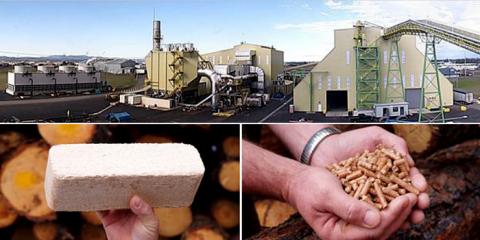Everything but the shade
August 06, 2012
I recently toured two Oregon sawmills and came away impressed with their innovation, technology and high degree of utilization. Today’s mills use every part of the tree except the shade. Efficient utilization of the wood resource is one of the keys to their staying in business.
At Seneca Sawmill in Eugene, long, debarked logs move along a conveyor into the “merchandiser,” where they are lifted and scanned in a process reminiscent of a full-body MRI. Based on current market prices, a computer calculates how the log should be cut.
Large-diameter logs go to the large-log mill to become dimension lumber; medium-size logs go to the stud mill to become 2x4s and 2x6s. The smallest logs, or “top wood,” – often barely 3 inches on the small end – go to the hew-saw mill, where they are first squared up or “hewed” by rotating knives and then made into studs. The chunks, chips, bark, sawdust and shavings by-products are sorted out and then either sold or used on-site.
On-site, the bark and hog fuel, along with other logging residues, feed Seneca’s cogeneration plant. The fuel burns so cleanly and the emissions are treated so effectively that the emitted air is virtually clear, with no particulates. Seneca Sustainable Energy provides steam to dry the lumber and also generates nearly 19 MW of electricity, which is sold to the local utility.
Another mill I toured recently, Malheur Lumber in John Day, which is part of Ochoco Lumber Company, has invested in a new product line that provides a market for small-diameter materials from forest restoration and thinning treatments in nearby national forests. Malheur Lumber makes forest biomass pellets and bricks for home, commercial and industrial heating systems.
Modern, innovative sawmills such as Seneca and Malheur employ local residents and inject thousands of dollars into local economies. They also provide important markets for the products of the active forest management needed to keep our forests healthy and sustainable.
As I look around the West, with its critical need for active forest management, I see many states with no mill infrastructure to use the byproducts of thinning and restoration efforts. In Oregon, we have 116 active primary wood-products mills, which is down from the 185 that operated in 2003. Let’s recognize the job they’re doing to modernize, use resources wisely and help sustain our forests and forest economies.
May the forest be with you,
Mike Cloughesy
Director of Forestry
Photos: Seneca Sustainable Energy in Eugene. Bricks and pellets at Malheur Lumber in John Day.
